The Herbal Medicinal Products Market is estimated to be valued at USD 230.9 billion in 2025 and is projected to reach USD 469.6 billion by 2035, registering a compound annual growth rate (CAGR) of 7.4% over the forecast period.
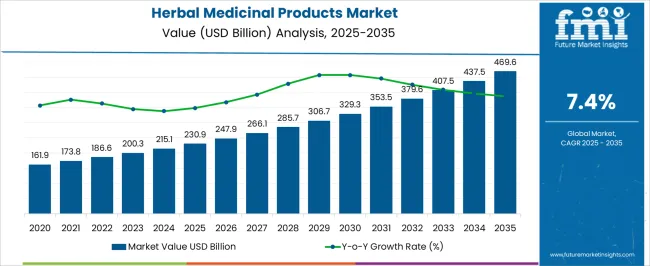
| Metric | Value |
|---|---|
| Herbal Medicinal Products Market Estimated Value in (2025 E) | USD 230.9 billion |
| Herbal Medicinal Products Market Forecast Value in (2035 F) | USD 469.6 billion |
| Forecast CAGR (2025 to 2035) | 7.4% |
The herbal medicinal products market is expanding steadily due to growing consumer preference for natural therapies, rising awareness of preventive healthcare, and an increasing shift toward alternative medicine practices. The market is supported by regulatory recognition of herbal remedies in various regions, along with greater acceptance of traditional systems such as Ayurveda, Traditional Chinese Medicine, and naturopathy.
Advancements in formulation technology and standardization practices are enhancing product efficacy, safety, and shelf life, which is fostering broader adoption across both developed and emerging economies. Rising investments by pharmaceutical and nutraceutical companies in research and branding of herbal products are strengthening trust among consumers.
The market outlook remains positive as demand for chemical free, plant based medicines continues to rise in line with wellness trends, self medication practices, and the global move toward sustainable healthcare solutions.
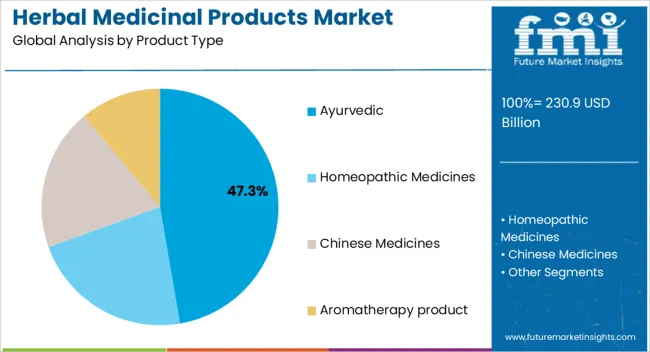
The Ayurvedic segment is projected to account for 47.30% of total revenue by 2025 within the product type category, making it the dominant segment. This growth is being driven by the strong heritage and wide acceptance of Ayurveda as a trusted healthcare system, particularly in Asia Pacific and increasingly in Western countries.
Rising consumer demand for herbal formulations addressing chronic conditions, immunity, and lifestyle related disorders has reinforced reliance on Ayurvedic products. Additionally, supportive government initiatives and growing international recognition are enabling expansion of Ayurvedic therapies across global markets.
These factors combined with continuous product innovation are establishing Ayurveda as the leading product type segment.
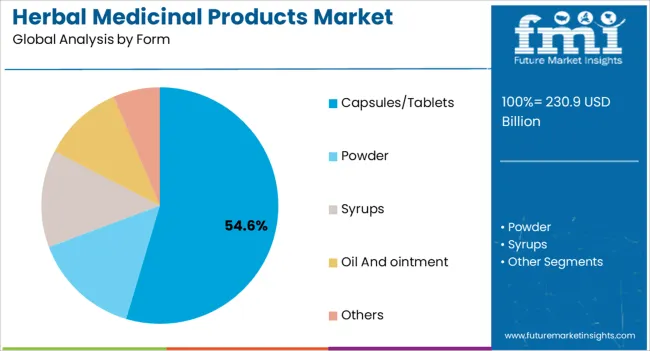
The capsules and tablets segment is expected to capture 54.60% of the total market revenue by 2025 under the form category, positioning it as the leading delivery format. This preference is driven by consumer demand for convenience, accurate dosing, and portability.
Capsules and tablets offer longer shelf life, ease of storage, and compatibility with global pharmaceutical manufacturing standards. Furthermore, the format supports controlled release and combination formulations, enhancing therapeutic effectiveness.
The rising inclination of consumers toward structured, easy to consume formats over traditional decoctions or powders has further strengthened the dominance of this form segment.
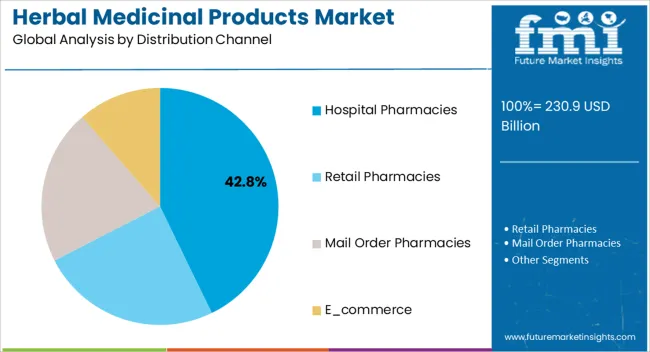
The hospital pharmacies segment is anticipated to contribute 42.80% of the overall revenue by 2025 within the distribution channel category, making it the largest segment. Growth in this segment is being driven by increasing patient reliance on hospital based care, rising trust in prescriptions from medical professionals, and the growing integration of herbal medicines in mainstream healthcare systems.
Hospital pharmacies provide a regulated environment, ensuring product authenticity and adherence to safety standards.
The rising prevalence of chronic illnesses and the adoption of integrative medicine approaches by hospitals have reinforced the role of hospital pharmacies as the leading distribution channel in the herbal medicinal products market.
As per Future Market Insights (FMI), the global market recorded a steady CAGR of 2.4% between 2020 and 2025. Increasing focus on alternative medicines with a focus on preventive measures is driving current sales figures. Expansion and product launches in emerging markets are key factors promoting market growth.
The transition from conventional to traditional medicines has bolstered growth in the industry due to increasing awareness about cost-effective herbal remedies. Herbal medicines, including homeopathy and health supplements, are finding traction as affordable and effective treatment options.
According to the National School of Medicine and Homeopathy, homeopathic medicines are 70% cost-effective compared to allopathic alternatives and 15% more cost-effective than generics.
The developing manufacturing sector in emerging economies is expected to promote market growth. Despite several challenges manufacturers face, the growing need for value-added products is likely to boost the market in the coming years.
As per WHO, around 21,000 plant species carry chemical constituents preferred for medicinal properties. Companies producing herbal medicinal products are actively strategizing business opportunities through acquisitions and partnerships to strengthen their portfolio.
The growth of the market is attributed to significant companies actively participating in acquisitions to expand their market presence.
In May 2020, Blackmores Limited expanded its 30,000 sq. soft gel and hard tablet manufacturing facility at Braeside in Victoria. Similarly, in June 2024, STADA expanded its European consumer healthcare portfolio by acquiring healthcare brands from Sanofi in key countries such as France, Germany, Italy, Poland, and Spain.
Ayurvedic medicine is estimated to show steady growth, reflecting a high share of 57% in 2025. Consumers are focused on preventive care as compared to treatments. As a result, many adult and senior consumers are opting for supplements from natural origins.
The herbal industry is driving the sales of supplements compared to herbal medicine due to the higher focus on herbal diets and lifestyles for the foreseeable future.
Capsules/tablets are projected to show steady growth in the forecast period with a CAGR of 8.5%, accounting for a market share of 43% in 2025. Several herbal drugs are formulated in tablet or capsule formats to prevent degradation and increase shelf life and bioavailability.
Despite hospital pharmacies leading the market, mail-order pharmacies have reflected significant growth with an 8.1% CAGR. Mail order is more convenient for consumers as a broader range of products are readily available in addition to better discounts and offers to minimize costs.
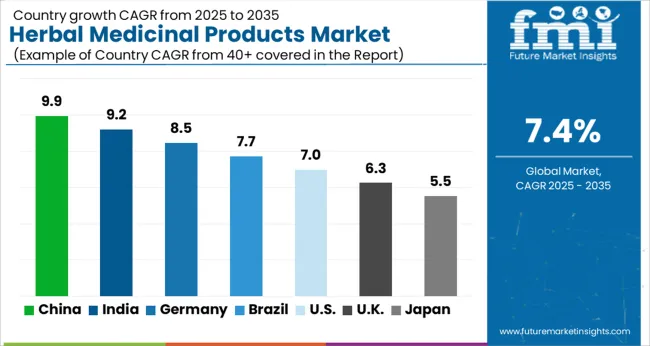
In 2025, The United States is estimated to account for over 69% value share in North America. The dominance is driven by higher health awareness.
Rising living standards, health consciousness, and increasing disposable incomes are boosting the demand for effective treatments with minimal side effects.
The adoption of stress and anxiety-relieving treatments, including aromatherapy and ayurvedic panchakarma, supplement market growth.
Herbal products are used by over 20% of the population, as per the 2024 Journal of General Internal Medicine data. Most herbs used in the country include garlic, ginkgo Bilbao, ginseng, St. John's Wort, and echinacea.
Germany is expected to account for over 18% of the Europe market by 2035. Increasing prescriptions of homeopathic medications in Germany drive demand. Homeopathy has developed into an essential element in the medicine industry.
According to a European Commission study in 2020, 3 out of 4 people in Western Europe are aware of homeopathy, and around 29% use homeopathic medicines regularly. In Germany, 94% of the population is aware of homeopathy, and 60% use this regularly.
The Australian market is estimated to exhibit a 7.8% CAGR throughout the forecast period. The appearance of e-commerce has produced boundless opportunities in Australia.
Growing product penetration through online retail channels is a significant factor driving market growth. Sales of herbal supplements through e-commerce are expected to grow significantly over the forecast period.
Buyers' demands for green label products are pushing manufacturers to change sales channels from niche distribution channels to majority mass retailers. Furthermore, retail pharmacy chains are also expanding product choices, which has resulted in higher sales in recent years.
Since ancient times, India has been the land of Ayurveda and herbal products. In India, around 70% of the population uses herbal products as a primary medication for various ailments.
Adopting complementary medication is attributed to the safety and efficacy of herbal medicines. Lower risk of side effects compared to mainstream medicines and escalating cost of conventional healthcare support growth in the country.
The market for herbal medicinal products in China is exhibiting an 11.8% CAGR and is expected to account for 57% of the East Asia market by 2035. China is one of the leading exporters of herbal medicines and essential oils, followed by India and Indonesia.
Favorable government policies, heavy investments in research, and high adoption of Chinese medicines by consumers support the Chinese traditional medicines industry.
According to the Chinese Journal of Traditional Chinese Medicine, around USD 3.0 billion worth of traditional Chinese medicines are exported from China each year. Similarly, the annual consultation of traditional Chinese medicine practitioners is more than 500 million, which accounts for around 20% of Chinese outpatients visits.
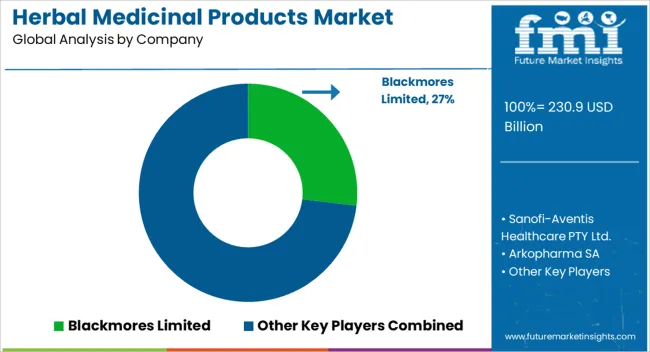
Herbal medicine manufacturers aim to carry out strategic expansions and file patents to consolidate growth in a competitive market. The herbal medicinal products market is highly competitive by several essential players that invest heavily in research and development activities.
They carry out unique and innovative products through research and development activities. The manufacturer is developing high-quality products as per their consumer's requirements.
The key players actively focus on acquiring maximum revenue through their various marketing strategies. These strategies are mergers, partnerships, agreements, collaborations, and product launches.
Recent Developments in the Global Herbal Medicinal Products Market are:
Other Essential Players in the Global Market are:
| Attribute | Details |
|---|---|
| Forecast Period | 2025 to 2035 |
| Historical Data Available for | 2020 to 2025 |
| Market Analysis | USD billion for Value |
| Key Countries Covered | The United States, The United Kingdom, Japan, India, China, Australia, Germany |
| Key Segments Covered | Product Type, Form, Distribution Channel, Region |
| Key Companies Profiled | Blackmores Limited; Sanofi-Aventis Healthcare PTY Ltd.; Arkopharma SA; Nutraceutical Corporation; STADA Arzneimittel AG; Himalaya Global Holdings Ltd; Integria Healthcare; Boiron Group; Young Living Essential Oils; Mountain Rose Herbs |
| Report Coverage | Market Forecast, Company Share Analysis, Competition Intelligence, DROT Analysis, Market Dynamics and Challenges, and Strategic Growth Initiatives |
| Customization & Pricing | Available upon Request |
The global herbal medicinal products market is estimated to be valued at USD 230.9 billion in 2025.
The market size for the herbal medicinal products market is projected to reach USD 469.6 billion by 2035.
The herbal medicinal products market is expected to grow at a 7.4% CAGR between 2025 and 2035.
The key product types in herbal medicinal products market are ayurvedic, homeopathic medicines, chinese medicines and aromatherapy product.
In terms of form, capsules/tablets segment to command 54.6% share in the herbal medicinal products market in 2025.






Full Research Suite comprises of:
Market outlook & trends analysis
Interviews & case studies
Strategic recommendations
Vendor profiles & capabilities analysis
5-year forecasts
8 regions and 60+ country-level data splits
Market segment data splits
12 months of continuous data updates
DELIVERED AS:
PDF EXCEL ONLINE
Herbal Nutraceuticals Market Size and Share Forecast Outlook 2025 to 2035
Herbal Supplement Market Analysis - Size, Share, and Forecast Outlook 2025 to 2035
Herbal Tea Market Analysis by Raw Material Type, Product Type, Flavor Type, Packaging Type, and Region Through 2035
Herbal Fragrance Ingredients Market Analysis by Application, Ingredients, and Region Through 2035
Herbal Beauty Product Market Growth – Trends & Forecast 2024-2034
Herbal Personal Care Products Market Size and Share Forecast Outlook 2025 to 2035
Pet Herbal Supplements Market Size and Share Forecast Outlook 2025 to 2035
Europe & Asia Pacific Herbal Beauty Products Market Trends – Growth & Forecast 2016-2026
Medicinal And Aromatic Plant Market Size and Share Forecast Outlook 2025 to 2035
Advanced Therapy Medicinal Products Market Size and Share Forecast Outlook 2025 to 2035
Products from Food Waste Industry Analysis in Korea Size, Share and Forecast Outlook 2025 to 2035
Products from Food Waste in Japan - Size, Share, and Forecast Outlook 2025 to 2035
Products from Food Waste Market Analysis - Size, Growth, and Forecast 2025 to 2035
USA Products from Food Waste Market Growth – Trends, Demand & Outlook 2025-2035
Teff Products Market
Detox Products Market Analysis - Size, Share, and Forecast Outlook 2025 to 2035
Algae Products Market Analysis - Size, Share, and Forecast Outlook 2025 to 2035
Pulse Products Market Analysis - Size, Share, and Forecast Outlook 2025 to 2035
Dairy Products Market Analysis by Product Type, End Use, Distribution Channel and Region through 2035
Almond Products Market Size and Share Forecast Outlook 2025 to 2035

Thank you!
You will receive an email from our Business Development Manager. Please be sure to check your SPAM/JUNK folder too.
Chat With
MaRIA